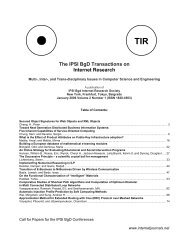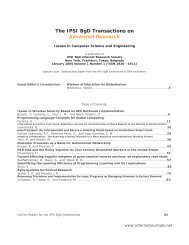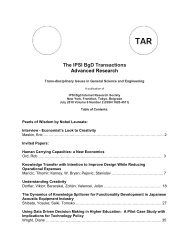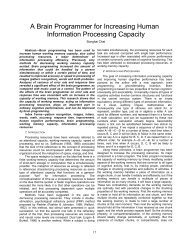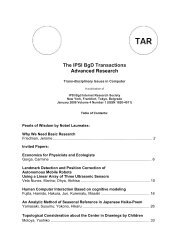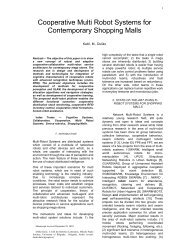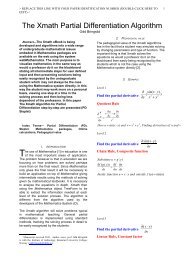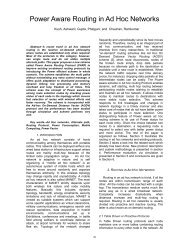Submited Paper (click here to see)
Submited Paper (click here to see)
Submited Paper (click here to see)
You also want an ePaper? Increase the reach of your titles
YUMPU automatically turns print PDFs into web optimized ePapers that Google loves.
usability analysis of real systems permits <strong>to</strong><br />
develop a field validation of the own system. This<br />
field-testing revealed a number of interesting<br />
aspects of the system; in particular, application of<br />
our validation methods – despite the treatment of<br />
the system as a black box – not only allowed the<br />
performance of the intelligent system <strong>to</strong> be<br />
compared with that of human experts, but also<br />
permitted it <strong>to</strong> acquire new knowledge and/or<br />
refine existing knowledge.<br />
5. CONCLUSIONS<br />
The main aim underlying the development of<br />
VISNU was <strong>to</strong> integrate different evaluation<br />
methods in a single <strong>to</strong>ol so as <strong>to</strong> benefit from the<br />
advantages of executing various evaluation<br />
methods <strong>to</strong>gether.<br />
Validation <strong>to</strong>ols can be applied <strong>to</strong> any<br />
intelligent system, given that they are<br />
independent of the underlying architecture of the<br />
system. Usability analysis <strong>to</strong>ols can be applied <strong>to</strong><br />
any computerised system since they involve no<br />
specific premises.<br />
It is also important <strong>to</strong> point out that the<br />
validation and usability analysis phases should<br />
be integrated in a natural way in the software<br />
development process. Intelligent systems are<br />
software products, and so the experience acquired<br />
by software engineers can also be applied<br />
<strong>to</strong> knowledge engineering. Nonetheless, the<br />
distinctive features of these systems and of their<br />
application domains would indicate that in terms<br />
of development and evaluation methodologies,<br />
these systems differ fundamentally from each<br />
other within the software engineering field, and<br />
for that reason specific evaluation techniques are<br />
required.<br />
REFERENCES<br />
[1] Mosqueira-Rey, E., Moret-Bonillo, V., “A Computer<br />
Program <strong>to</strong> Assist Developers in Validation and Usability<br />
Analysis of Intelligent Systems,” IPSI BgD Proc., VIP<br />
Scientific Forum of the IPSI Montenegro Conf., 2004.<br />
[2] Adrion, W.R., Branstad, M.A., Cherniavsky, J., “Validation,<br />
verification and testing of computer software,”<br />
Computing Surveys, vol. 14, no. 2, 1982, pp. 159-192.<br />
[3] Hoppe, T., Meseguer, P. “VVT Terminology: A<br />
Proposal,” IEEE Expert, vol. 8, no. 3, 1993, pp. 48-55.<br />
[4] Adelman, L., Riedel, S.L., “Handbook for Evaluating<br />
Knowledge-Based Systems,” Kluwer Academic<br />
Publishers, Bos<strong>to</strong>n, 1997.<br />
[5] Juris<strong>to</strong>, N., Morant, J.L., “Common Framework for the<br />
Evaluation Process of KBS and Conventional Software,”<br />
Knowledge-Based Systems, vol. 11, 1998, pp. 145-159.<br />
[6] Boehm, B.W. “Software Engineering Economics,”<br />
Prentice-Hall, Englewood Cliffs, NJ, 1981.<br />
[7] O’Keefe, R.M., Balci, O., Smith, E.P. “Validating Expert<br />
System Performance,” IEEE Expert, vol. 2, no. 4, 1987,<br />
pp. 81-89.<br />
[8] O'Keefe, R.M., O'Leary, D.E., “Expert System Verification<br />
and Validation: a Survey and Tu<strong>to</strong>rial,” Artificial<br />
Intelligence Review, vol. 7, no. 1, 1993, pp 3-42.<br />
[9] Gupta, U.G. (ed.) “Validating and Verifying Knowledge-<br />
Based Systems,” IEEE Computer Society Press, Los<br />
Alami<strong>to</strong>s, California, 1991.<br />
[10] Murrel S., Plant R.T. “A survey of <strong>to</strong>ols for the validation<br />
and verification of knowledge-based systems: 1985-<br />
1995,” Decision Support Systems, vol. 21, 1997, pp.<br />
307-323.<br />
[11] Swets, J.A. “Measuring the accuracy of diagnostic<br />
systems,” Science, vol. 240, 1988, pp. 1285-1293.<br />
[12] Sackman, H. “Delphi Assessment: Expert Opinion,<br />
Forecasting and Group Process,” The Rand Corporation,<br />
Santa Monica, CA, 1974.<br />
[13] Nielsen, J. “Usability Engineering,” Morgan Kaufmann,<br />
San Francisco, 1994<br />
[14] Nielsen, J., Mack, R.L., (eds.) “Usability Inspection<br />
Methods,” John Wiley & Sons, New York, NY, 1994.<br />
[15] Preece, J., “A Guide <strong>to</strong> Usability: Human Fac<strong>to</strong>rs in<br />
Computing,” Addison-Wesley, Reading, MA, 1993.<br />
[16] Ivory, M., Hearst, M. “The State of the Art in Au<strong>to</strong>mated<br />
Usability Evaluation of User Interfaces,” ACM Computing<br />
Surveys, vol. 33, no. 4, 2001, pp. 173-197.<br />
[17] Card, S.K., Moran, T.P., Newell, A., “The Psychology of<br />
Human-Computer Interaction,” Lawrence Erlbaum<br />
Associated, Hillsdale, NJ, 1983.<br />
[18] Winterfeld, D., Edwards, W., “Decision Analysis and<br />
Behavioral Research,” Cambridge University Press,<br />
Cambridge, England, 1983.<br />
[19] Saaty, T.L. “The Analytic Hierarchy Process,” McGraw-<br />
Hill, New York, 1980.<br />
[20] Mosqueira-Rey, E., de la Rocha, J.G.F.G., Moret-Bonillo,<br />
V. “Design of a Validation Tool Based on Design<br />
Patterns for Intelligent Systems,” Lecture Notes in<br />
Computer Science, vol. 2774, 2003, pp. 1365-1372.<br />
[21] Mosqueira-Rey, E., Moret-Bonillo, V., “Validation of Intelligent<br />
Systems: A Critical Study and a Tool,” Expert<br />
Systems with Applications, vol. 18, no. 1, 2000, pp. 1-16<br />
[22] Jobson, J.D. “Applied Multivariate Data Analysis,”<br />
Springer-Verlag, New York, 1992.<br />
[23] Mosqueira-Rey, E., Moret-Bonillo, V. “Intelligent Interpretation<br />
of Validation Data,” Expert Systems with<br />
Applications, vol 23, no. 3, 2002, pp. 189-205.<br />
[24] Mosqueira-Rey, E., Rivela Carballal, J., Moret-Bonillo,<br />
V. “Integrating GOMS Models and Logging Methods in<strong>to</strong><br />
a Single Tool for Evaluating the Usability of Intelligent<br />
Systems,” Proc. IEEE Int. Conf. on Systems, Man and<br />
Cybernetics, 2004, pp. 5142-5147.<br />
[25] Moret-Bonillo, V., Mosqueira-Rey, E., Alonso-Betanzos,<br />
A. “Information Analysis and Validation of Intelligent<br />
Moni<strong>to</strong>ring Systems in Intensive Care Units,” IEEE<br />
Transactions on Information Technology in Biomedicine,<br />
vol. 1, no. 2, 1997, pp. 87-99.<br />
[26] Alonso-Betanzos, A., Mosqueira-Rey, E., Moret-Bonillo,<br />
V., Baldonedo, B. “Applying Statistical, Uncertainty-<br />
Based and Connectionist Approaches <strong>to</strong> the Prediction<br />
of Fetal Outcome: A Comparative Study,” Artificial<br />
Intelligence in Medicine, vol. 17, no. 1, pp. 37-57, 1999.<br />
[27] Guijarro-Berdiñas, B., Alonso-Betanzos, A., “Intelligent<br />
Analysis and Pattern Recognition in Cardi<strong>to</strong>cographic<br />
Signals Using a Tightly Coupled Hybrid System,”<br />
Artificial Intelligence, vol. 136, no. 1, 2002, pp. 1-27.<br />
[28] Cabrero-Canosa, M., et al. "A Methodologycal Approach<br />
<strong>to</strong> Validate the Intelligent Moni<strong>to</strong>ring System 'Midas'," Int.<br />
Conf. Neural Networks and Expert Systems in Medicine<br />
and HealthCare, 2001, vol. 1, pp. 245-253.<br />
[29] Mosqueira-Rey, E., Cabrero-Canosa, M., Hernández-<br />
Pereira, E., Moret-Bonillo, V. “Usability Analysis of an<br />
Intelligent Moni<strong>to</strong>ring System,” Proc. 2nd European<br />
Med. & Biol. Eng. Conf. (EMBEC'02), vol. I, 2002, pp.<br />
758-759.<br />
E. Mosqueira-Rey received the degree in computer science<br />
in 1994 and the PhD degree in computer science in 1998,<br />
both from the University of A Coruña, Spain. He is currently<br />
associate professor in the Department of Computer Science,<br />
University of A Coruña. He is a member of the IASTED<br />
Technical Committee on Art. Intelligence & Expert Systems.<br />
V. Moret-Bonillo received the degree in physical chemistry in<br />
1984, and the PhD degree in physics in 1988, both from the<br />
University of Santiago de Compostela, Spain. From 1988<br />
through 1990 he was a postdoc<strong>to</strong>ral fellow in the Medical<br />
College of Georgia at Augusta, GA. He is currently associate<br />
professor in the Department of Computer Science, University<br />
of A Coruña w<strong>here</strong> he leads a research group awarded as<br />
‘group of excellence’ by the regional government. He is a<br />
member of various scientific societies: IEEE, ACM, etc.<br />
45



